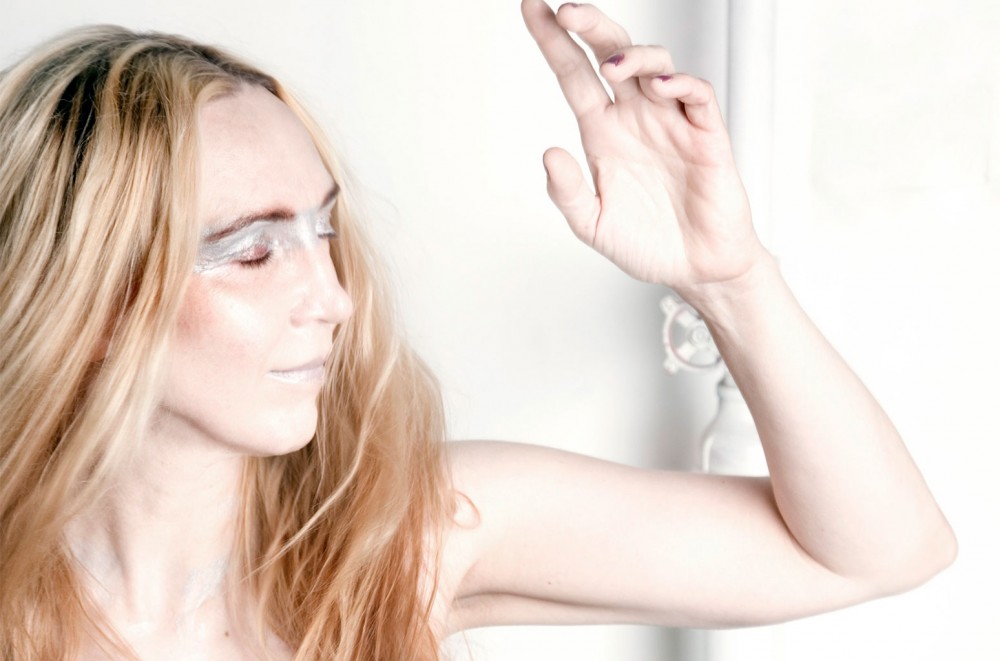
Jarboe examines time, perception and the self on the lilting title track.
Different voices, dialects and characters are simultaneously vying to get out of Jarboe’s head — and, ultimately, her mouth. She releases them in some harmonious cacophony, each giving perspective to her lyrical stories.
“I have this tendency when writing lyrics to be more than one character, more than one person,” says the former Swans vocalist-keyboardist, who was in the band from 1985 through its demise in 1997. “I do it a lot.” When she vocally takes on these personas, they syncopate through seven expansive tracks on Jarboe’s upcoming album, Illusory (April 17, Consouling Sounds).
Deliberately flowing, there’s no dissonance on Illusory; it freely transitions from one track to the next. “It’s exploring the illusion of the perception of self,” explains Jarboe. “This is why there are inarticulate vowels on the tracks that are referencing the sounds of other languages, but they’re actually vowels and sounds, and you’re supposed to experience the illusion and perception in that as well.”
Jarboe lilts through the keys of the haunting and mystical “Illusory,” a look at time and perception, what the self is and how one identifies with it. “It’s almost like a duet, but it’s just my voice,” she says of the title track. “It’s basically all the different sides of our thoughts, so the narrator is exploring what does it mean to be myself and have I healed from past trauma and pain. I say that time heals, but is time actually a real thing?”
The song moves between the third and first person perspective and ends in the lyrics “I’m still her” and a sudden, quick draw of her breath. “It’s deliberate to sound like a snap, like a zen master or a Tibetan monk master slapping the person on the side of the face to wake them up out of delusion,” says Jarboe. “It’s also a play on words — her, here — so a person can interpret it as singing to a lover or singing to a friend or singing to themselves.”
The concept of Illusory — the explanation and illusion of the self — is taken from Buddhism. It also spilled into her 2018 album The Cut of the Warrior (the set’s cover depicts a Buddhist nun with cuts on her back, a metaphor for the repeated efforts to cut the ego) and appeared as far back as her second album, 1995’s Sacrificial Cake. “Tibetan Buddhism really opened up my world,” says Jarboe, who grew up Roman Catholic. “I really saw a big reference point with the Roman Catholic mass, so the ritualistic aspect of it, the visualization of the deities — which is quite horrific and can give you serious [LSD-like] experiences just through visualization — that’s what I like about it.”
Stimulated more by its fantastic elements, Jarboe says Buddhist “studies” are a dominant part of her life: “As Westerners, I don’t believe that we can fully understand it. I read the text. I read the books. I go to the lectures. I go to the events. I do the meditations, [and] I do the visualizations. It’s like going back to college, so yes, I would say it’s a huge part of my life.”
Watch the video for “Illusory” below:
In the track “Cathedral,” water drips off moss-covered stones inside a hallowed space surrounded by outside noises that float through the hymn of “a compilation of shadowy sounds” Jarboe gathered during her 2017 European tour with Italian psychedelic duo Father Murphy. It features noises inside an actual church, and in the distance, a tour group passes through and cell phones go off before a choir sets in. “You can definitely get the ambience there, and then there’s the singing,” she says. “If the person is listening carefully, they’re being interrupted. The idea is that in a public space you cannot do that — and then the choir comes in.”
Illusory also contains a more abstract, brooding reinterpretation of “A Man of Hate” from 1991’s Thirteen Masks. Keeping a “complicated arrangement” as only Jarboe can, Illusory’s “Man of Hate” incorporates multiple voices — all done by her shifting her tonality — that sound like different people speaking as the track closes eerily with organ and applause. “The whole point of that piece is supposed to be done in a theater, an Elizabethan kind of language,” Jarboe says. “It’s a perfect thing to do onstage.”
She notes that “Man of Hate” is not just pointing the finger at someone, for the lyrics say, “I am, I am. I’m the man of hate.” “It’s talking about the cause and effect of how a person, how a culture gets to a certain place,” she explains, linking the track to “The Rally” off her 2017 project as mind dissolves as song begins, which featured a subversive recording from Donald Trump’s 2016 U.S. presidential campaign.
“I couldn’t believe the chanting of ‘Lock her up.’ It completely blew my mind,” she says of now-President Trump’s rallying call against then-rival Hillary Clinton. “I had to do something in the context of what I was reading at the time [The Love Poems of Rumi by Nader Khalili]. So the whole thing with that album was combining love from the Persian Sufi poet Rumi’s point of view with what I was seeing in my country.”
Speaking of her country, her home in Georgia is another fundamental part of Jarboe’s world. Now residing 30 minutes north of downtown Atlanta in the more rural city of Roswell, it’s a different world altogether from where she once lived with Swans frontman Michael Gira. “I never saw herds of deer in Atlanta,” says Jarboe. “There are a lot of memories associated with the house in Atlanta because I lived there with Michael. I had many memories and lots of guests there — even some famous rock stars visiting — but I think I’m happier here.”
Their relationship ended in 1997 (which she discusses in the Marco Porsia-directed 2019 Swans documentary Where Does a Body End?), and Swans broke up the same year. “I always said he ended Swans, and that’s why we broke up,” recalls Jarboe. “It wasn’t like the other way around. The tension [prior to the band’s split] was already there — the frustration of the art and of the music. All the other problems, including the alcoholism that he had, was a big part of it. I’ve never been part of that, so it was a real struggle to be around that culture.”
Jarboe suffered post-traumatic stress disorder after finding out from fans that the act had reunited in 2010, having nightmares and reliving shows and memories. “When you’re in something and you give as much as I did, you feel like it’s part of your soul,” she says. “The music and the performances were part of my soul, so the relationship or how I got along, or didn’t get along, with Michael was secondary to me.”
Still, Swans will forever be part of her. In 2012, Jarboe guested on the group’s The Seer and reunited with the act for a 2016 Atlanta show. If asked, she says she would work with Swans again, but has been saying no more than yes to collaborations to focus on Illusory. It’s Jarboe’s 33rd album in addition to nearly 30 years of collaborations, including her work with Gira on The World of Skin project (1987-90), 1993’s Beautiful People with early Swans multi-instrumentalist Lary Seven, J² with Godflesh drummer Justin Broadrick in 2008 and recent collaborative pieces with Father Murphy and cellist-composer Helen Money.
“I really love creating music,” she says. “The more complicated and bizarre and evocative, the better. So that’s what I’m going to keep focusing on. Of course, there’s a learning curve, but I think it’s what I’m here to do, so it’s what I’m going to do.”


 94
94